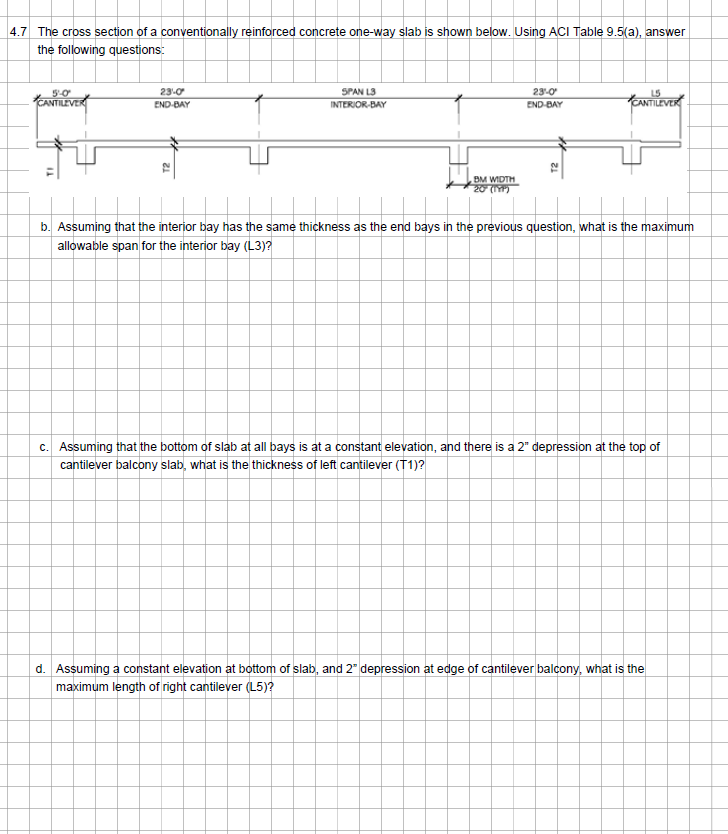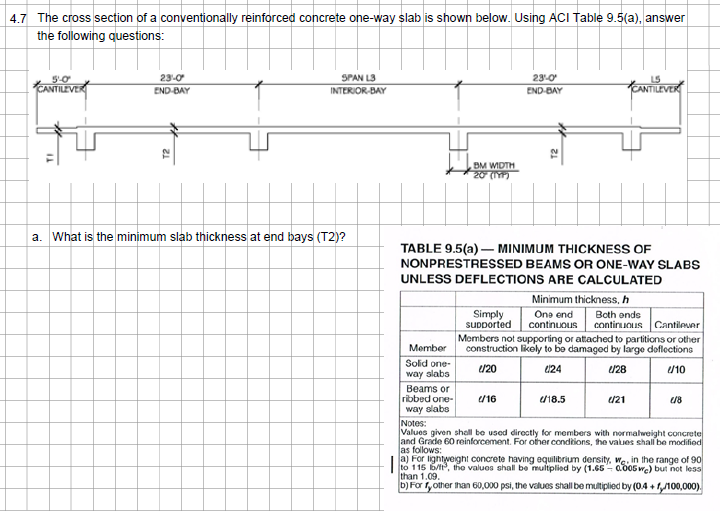4.7 The cross section of a conventionally reinforced concrete one-way slab is shown below. Using ACI Table 9.5(a), answer the following questions: 5-0 CANTILEVER 23-0 END-BAY T2 SPAN L3 INTERIOR-BAY BM WIDTH 20 (197) 23-0 END-BAY 12 CANTILE b. Assuming that the interior bay has the same thickness as the end bays in the previous question, what is the maximum allowable span for the interior bay (L3)? c. Assuming that the bottom of slab at all bays is at a constant elevation, and there is a 2" depression at the top of cantilever balcony slab, what is the thickness of left cantilever (T1)? d. Assuming a constant elevation at bottom of slab, and 2" depression at edge of cantilever balcony, what is the maximum length of right cantilever (L5)?
4.7 The cross section of a conventionally reinforced concrete one-way slab is shown below. Using ACI Table 9.5(a), answer the following questions: 5-0 CANTILEVER 23-0 END-BAY T2 SPAN L3 INTERIOR-BAY BM WIDTH 20 (197) 23-0 END-BAY 12 CANTILE b. Assuming that the interior bay has the same thickness as the end bays in the previous question, what is the maximum allowable span for the interior bay (L3)? c. Assuming that the bottom of slab at all bays is at a constant elevation, and there is a 2" depression at the top of cantilever balcony slab, what is the thickness of left cantilever (T1)? d. Assuming a constant elevation at bottom of slab, and 2" depression at edge of cantilever balcony, what is the maximum length of right cantilever (L5)?
Chapter2: Loads On Structures
Section: Chapter Questions
Problem 1P
Related questions
Question

Transcribed Image Text:4.7 The cross section of a conventionally reinforced concrete one-way slab is shown below. Using ACI Table 9.5(a), answer
the following questions:
5-0
CANTILEVER
23-0
END-BAY
T2
SPAN L3
INTERIOR-BAY
BM WIDTH
20 (197)
23-0
END-BAY
12
CANTILE
b. Assuming that the interior bay has the same thickness as the end bays in the previous question, what is the maximum
allowable span for the interior bay (L3)?
c. Assuming that the bottom of slab at all bays is at a constant elevation, and there is a 2" depression at the top of
cantilever balcony slab, what is the thickness of left cantilever (T1)?
d. Assuming a constant elevation at bottom of slab, and 2" depression at edge of cantilever balcony, what is the
maximum length of right cantilever (L5)?

Transcribed Image Text:4.7 The cross section of a conventionally reinforced concrete one-way slab is shown below. Using ACI Table 9.5(a), answer
the following questions:
5'-0"
CANTILEVER
TI
23-0
END-BAY
T2
SPAN L3
INTERIOR-BAY
a. What is the minimum slab thickness at end bays (T2)?
Member
Solid one-
way slabs
BM WIDTH
Beams or
ribbed one-
way slabs
TABLE 9.5(a)- - MINIMUM THICKNESS OF
NONPRESTRESSED BEAMS OR ONE-WAY SLABS
UNLESS DEFLECTIONS ARE CALCULATED
Simply
supported
23-0
END-BAY
12
€/16
CANTILEVER
Minimum thickness, h
Both ends
One end
continuous continuous Cantilever
Members not supporting or attached to partitions or other
construction likely to be damaged by large deflections
1/20
024
U/28
U/10
d/18.5
(21
€/8
Notes:
Values given shall be used directly for members with normalweight concrete
and Grade 60 reinforcement. For other conditions, the values shall be modified
as follows:
a) For lightweight concrete having equilibrium dersity, we, in the range of 90
to 115 loft, the values shall be multiplied by (1.65-0005 we) but not less
than 1.09.
b) For f, other than 60,000 psi, the values shall be multiplied by (0.4+ f/100,000).
Expert Solution
This question has been solved!
Explore an expertly crafted, step-by-step solution for a thorough understanding of key concepts.
This is a popular solution!
Trending now
This is a popular solution!
Step by step
Solved in 2 steps with 1 images

Knowledge Booster
Learn more about
Need a deep-dive on the concept behind this application? Look no further. Learn more about this topic, civil-engineering and related others by exploring similar questions and additional content below.Recommended textbooks for you


Structural Analysis (10th Edition)
Civil Engineering
ISBN:
9780134610672
Author:
Russell C. Hibbeler
Publisher:
PEARSON

Principles of Foundation Engineering (MindTap Cou…
Civil Engineering
ISBN:
9781337705028
Author:
Braja M. Das, Nagaratnam Sivakugan
Publisher:
Cengage Learning


Structural Analysis (10th Edition)
Civil Engineering
ISBN:
9780134610672
Author:
Russell C. Hibbeler
Publisher:
PEARSON

Principles of Foundation Engineering (MindTap Cou…
Civil Engineering
ISBN:
9781337705028
Author:
Braja M. Das, Nagaratnam Sivakugan
Publisher:
Cengage Learning

Fundamentals of Structural Analysis
Civil Engineering
ISBN:
9780073398006
Author:
Kenneth M. Leet Emeritus, Chia-Ming Uang, Joel Lanning
Publisher:
McGraw-Hill Education


Traffic and Highway Engineering
Civil Engineering
ISBN:
9781305156241
Author:
Garber, Nicholas J.
Publisher:
Cengage Learning